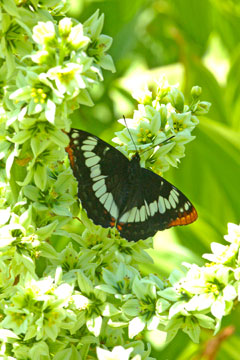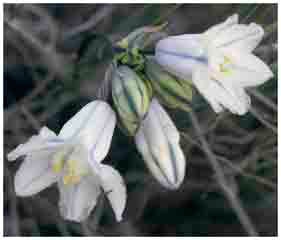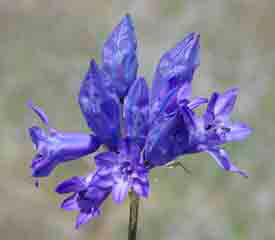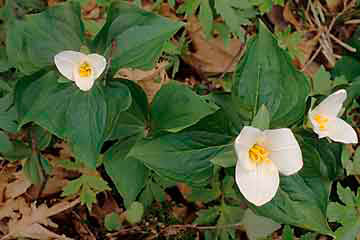 |
Western trillium, Trillium ovatum Pursh
(left, right) is a spring flower that often blooms while
surrounded by banks of snow. The name “ovatum” refers to
its pointed, oval leaves. Its three-petaled flowers are white, turning pink
and then a light purple as they mature (right). Trillium flowers vary in
size; tending to be smaller at higher elevations. We have not seen trilliums
growing south of the Clearwater River drainage. Meriwether Lewis collected
the western trillium on the Columbia River below today’s The Dalles,
on April 10, 1806.
On June 15, 1806, while on the Lolo Trail, Lewis and Clark collected
Trillium petiolatum Pursh (the purple trillium, not shown),
It is an uncommon species, characterized by a reddish-purple three- petaled
flowers and long-stemmed round leaves. The plant is found the northern half
of Idaho and in Washington and Oregon.
|
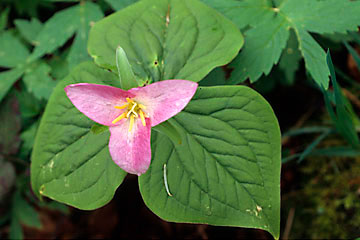 |
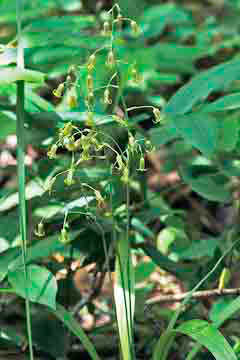 |
Western stenanthium, Stenanthium
occidentale A. Gray (left,
right) grows along stream banks, and in moist meadows. We have seen it growing
only in the northern part of Idaho. Dainty, nodding, bronze-colored, lily-like
flowers with six recurved tepals are borne on downward-curving stemlets that
come off at intervals along a slender stem. Several moderately wide leaves
surround the base. Stenanthium is derived from two Greek words meaning
“narrow flower,” apparently for their small size. |
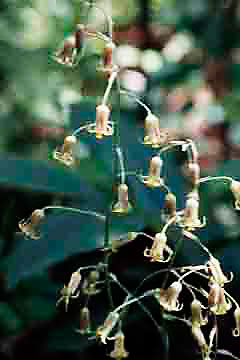 |
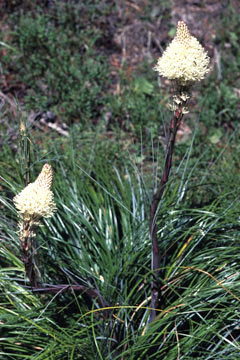 |
Bear grass, Xerophyllum tenax
(Pursh) Nutt. (left, right). Bear grass (also
Indian basket grass) is one of the Northwest’s more spectacular plants.
A basal tuft of leaves (the “grass”) forms during snowmelt.
A few weeks later, a tall stalk tipped with myriad tiny lily-like blooms
appears. The leaves are ideally suited for basket making for they are strong,
hard, and even in width almost to their tips. Lewis and Clark saw baskets
woven from the grass during the winter of 1805-1806 while at the
expedition’s Fort Clatsop on the Columbia estuary. Then, the following
spring, while in today’s Idaho, they saw the plants blooming. Lewis
collected two intact blooms during the crossing of the Lolo Trail (June 15,
1806).We have not seen bear grass in Idaho south of the southern approach
to Lost Trail Pass (US Rt. 93) on the Idaho-Montana border. |
 |
 |
Note: The three death
camases shown here (elegant, foothill and meadow death camas) were formerly
in the genus Zigadenus, and are so listed in most guidebooks. They
have recently been reassigned to the genera listed here.
Elegant camus, Anticlea elegans (Pursh)
Rydb. (left, right). The elegant camas (also mountain
death camas, formerly Zigadenus elegans) grows, sometimes in great
numbers, in mountain meadows as high as treeline. Usually about a foot high,
the plant may grow to twice that height in favorable situations. It blooms
from early to mid-summer, according to elevation. As the name elegans
suggests, it is the most attractive of our three death camases. Its white
flowers are large and the tepals are marked with heart-shaped green
“glands” at their bases. All of the death camases are poisonous;
this one is said to be least so. The elegant camas was collected by Meriwether
Lewis in the vicinity of today’s Lewis and Clark Pass near Lincoln,
Montana, on July 7, 1806. |
 |
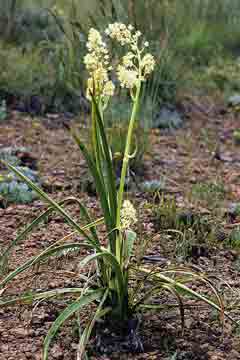 |
Foothill death camas, Toxicoscordion
paniculatum (Nutt.) Rydb. (left) appears
in early spring, mostly on dry ground. It blooms at about the same time as
the common camas, usually in early June. A naked stem is topped by a cluster
of small, white, six-tepaled flowers. The flowers have six anthers that protrude
beyond the tepals, and three styles. Several flowers are borne on each stemlet
(botanically, these are panicles, explaining its scientific species name).
The closely related and very similar meadow death camas, Toxicoscordion
venenosum (S. Watson) Rydb. (right)—the species Latin name means
“very poisonous”—has larger, tight-clustered flowers, one
flower to each stemlet. Both plants are poisonous and may be lethal
to browsing animals, or to humans if they eat the roots. The generic name
Toxicoscordion, from the Greek, means “poisonous garlic.”
|
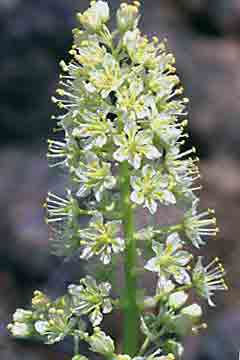 |
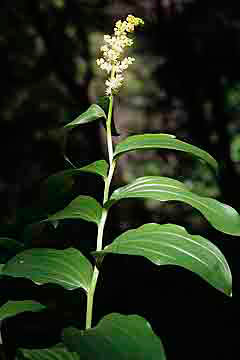 |
Feathery false Solomon’s seal, Maianthemum
racemosum (L.) Link (left).
The feathery false Solomon’s seal (also western false Solomon’s
plume, and wild lily of the valley) is a common plant found in much of North
America. Until recently the two false Solomon's seals shown here were in
the genus Smilacina. On the basis of recent studies, however, they
have reassigned to the butcher’s broom family (Ruscaceae) and to the
genus Maianthemum. (The latter name was derived from two Greek words
for “May” and “flower.”). The maianthemums, and many
similar lily-like plants, commonly grow on moist soil, and often in forest
shade. Deep green, parallel-veined leaves, and a cluster of small-petaled,
yellow-anthered, white flowers make identification easy. Green berries turn
red as they ripen.
Starry false Solomon’s seal, Maianthemum stellatum
(L.) Link (right) has many common names. These include star-flowered
(or western) Solomon’s plume, wild (or false) lily of the valley and
others. The plant is quite similar in appearance to the feathery false
Solomon’s seal shown on the left, differing in that its leaves are narrower,
its tepals are larger, and the flowers are star-shaped (the species name,
stellata, is derived from the Latin word stella for
“star”). |
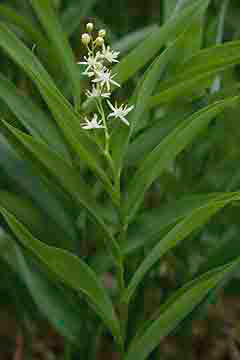 |
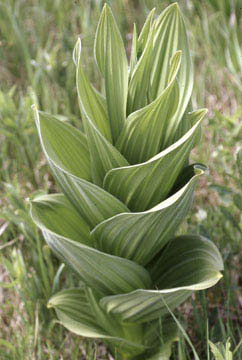
![]()
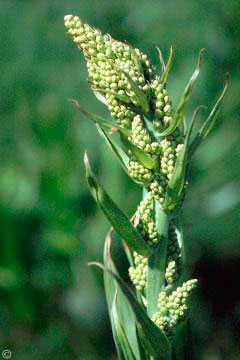
![]()

![]()

![]()
